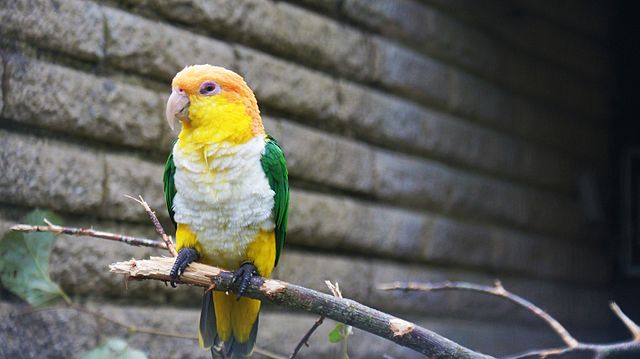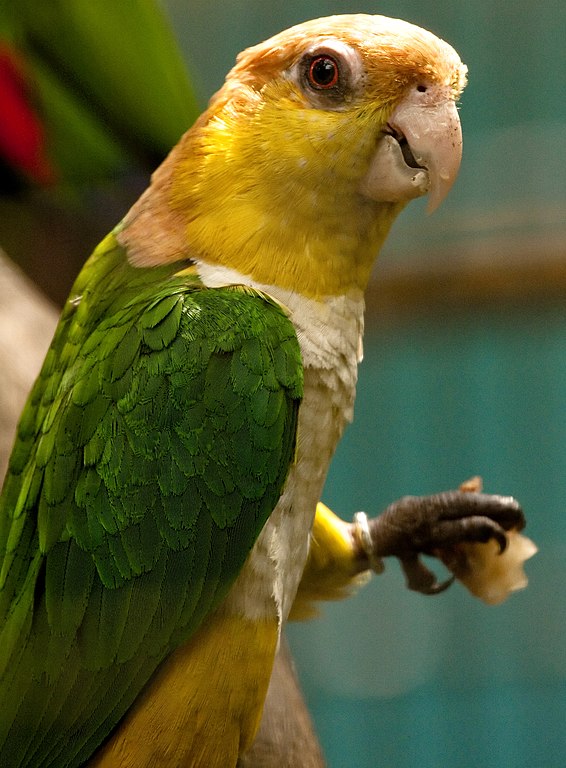The White Bellied Caique is a playful, amusing, and entertaining bird. Their colorful plumage is so vivid that they are known as the “clown” of the Parrot world. Many people are interested in the White Bellied Caique as pets because they are small, weighing in at less than six ounces.
They don’t have the speaking ability of their larger parrot cousins, but they are very active and can make great pets. While this may make them seem like an ideal bird companion, there are a few things to consider before bringing a Caique into your home.

The Caique (pronounced kigh-eek) is a medium-sized parrot that is, like many other parrots, native to South America. You can recognize it by its vivid green, yellow, orange, and white colors. Interestingly, they are the only parrot that has a pure white belly or breast, except for cockatoos.
There are three subspecies of the White Bellied Caique. The main or largest of the subspecies is commonly known as the “Green-Thighed” White Bellied Caique. Its scientific name is Pionites leucogaster leucogaster. It has not been captured and exported as a pet in large numbers, although you may find them on occasion.
The second subspecies is the “Yellow-Thighed” White Bellied Caique. Their scientific name is Pionites leucogaster xanthomeria. It is this species that is most commonly seen as a pet in the United States. If searching for one of these, you may find them listed as either “Yellow-Thighed” or “White Bellied.” You can also check out the Black Headed Caique.
The “Yellow Tailed Caique” is the last of the White Bellied Caique subspecies. Its scientific name is Pionites leucogaster xanthurus. This Caique is pale when compared to the other two subspecies and has a yellow tail. As of this time, none of these birds have been found in the United States as a pet, however, they have been known to be bred and kept in some areas of Europe.
In the wild, the White Bellied Caique can be found in pairs or family groups south of the Amazon River. They can also be seen in flocks of up to 30 birds. Their normal habitat is coastal forests and the forest canopy. Most likely they will be found in Brazil, Ecuador, Peru, and Bolivia. Like most parrots, they prefer fruits, berries, and seeds to eat. In captivity, it is important to include flaxseed in their diet.
White Bellied Caiques are smaller than most parrots found as pets growing to around 9 inches from the top of the head to the tip of their tail. Like many parrots, they are monomorphic, meaning you can’t tell the difference between the two merely by looking at them. They are expected to live around 30 years, although with excellent care it could be longer.
Training Your White Bellied Caique

Caiques have a reputation as being playful; often found lying on their backs playing with their toys. They bond easily and well with their human flock and, as parrots, are very social birds. They aren’t considered to be good flyers and can often be seen climbing, jumping, or walking rather than using their wings. This is important to know because in order to have a happy Caique, it must have room to be active and play. Training your Caique is also a very important part of their happiness.
The White Bellied Caique behaves much like a lorikeet and is trained fairly easily if you take the time to do so properly. Like most parrots, they spend a good deal of time chewing on anything they can get their beak on, unfortunately sometimes they chew things they shouldn’t. It is for this reason that you need to be aware of what is in your home that could be hazardous to your bird.
They aren’t comfortable with other birds, so if you’re considering purchasing a White Bellied Caique, you may want to make sure it’s a solo companion or your other birds are also Caiques.
While they can be quite loud, often compared to the sound of a fire alarm, they don’t do well at imitating human speech.
They can, however, learn to mimic whistles and sounds from your home such as a telephone ringing. Like human beings, they can be grumpy and aggressive; therefore leaving them with other pets is discouraged.
A White Bellied Caique requires a roomy cage unless you’re comfortable leaving your Caique out of its cage for long periods of time. They do have a tendency to bite if they are overloaded emotionally, but they can be trained not to bite using positive reinforcement and rewards. Having an ample supply of destructible toys may also help them to get their chewing needs at a place other than your fingers.
The White Bellied Caiques are considered in decline in parts of Brazil due to deforestation, however, they can be found in some reserves in Brazil and Peru. They are relatively new to those selling parrots, however, that is expected to change. The White Bellied Caique is outgoing, curious, and considered to be a good choice as a pet parrot if you’re willing to take the time to train them and provide an optimal Caique environment.
